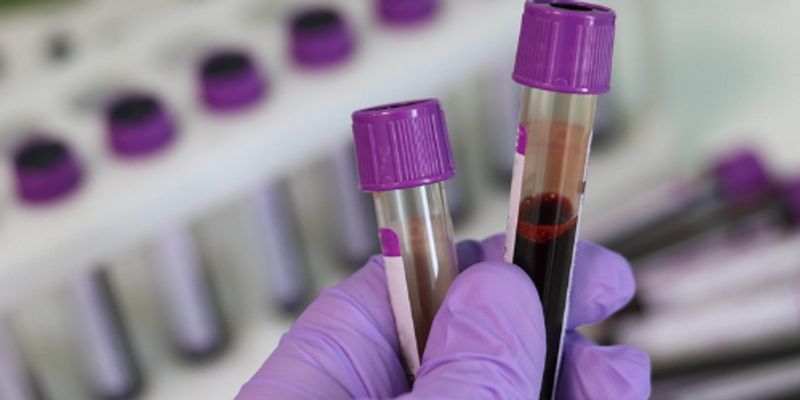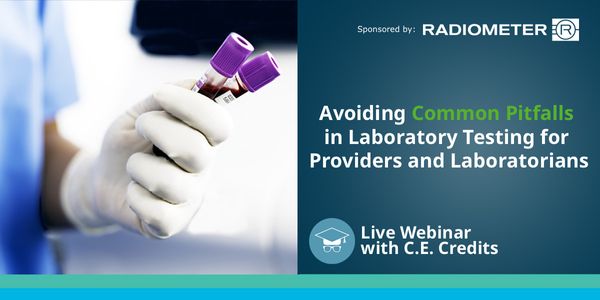Preanalytic
The preanalytic phase of laboratory quality includes variables that could impact the biological readings obtained from a specimen collected from a patient. Specimens could include collection of blood, a urine sample, or a biopsy. The preanalytic phase includes the method for specimen collection, how it is handled from the time it is obtained until it is tested, and how it is processed to generate the necessary biological readout.
-
JUN 19, 2024 | 8:30 AMJoin us for an illuminating webinar as we delve into the realm of open automation with Inpeco, the global leader in Total Laboratory Automation. Discover how their groundbreaking s...OCT 04, 2023 | 10:00 AMC.E. CREDITSCurrent clinical methods used to identify epithelial ovarian cancer are often too late – when the cancer is at an advanced stage, leaving the patient with limited therapeutic options....SEP 20, 2023 | 11:00 AMC.E. CREDITSPreanalytical errors and unsuitable samples can account for up to 70% of lab errors. 1 These errors can be attributed to improper specimen collection, specimen transportation, and specimen p...MAY 31, 2023 | 8:00 AMC.E. CREDITSDo you have questions about Tissue Processing? Robin Fitzl, Senior Application Specialist at Leica Biosystems, has the answers! As part of her popular “Lessons from the Laboratory&rdqu...APR 28, 2023 | 12:00 AMC.E. CREDITSHeparin-Induced Thrombocytopenia (HIT): Practical Aspects of Clinical and Laboratory Diagnosis Heparin-Induced Thrombocytopenia (HIT) is a life-threatening complication following heparin exp...Speaker: Jerrold Levy. MD, FAHA, FCCMAPR 27, 2023 | 12:00 AMC.E. CREDITSDate: April 27, 2023 Time: 12:00am (PDT), 3:00am (EDT), 9:00am (CEST) Do you have questions about Tissue Processing? Robin Fitzl, Senior Application Specialist at Leica Biosystems, has the a...APR 24, 2023 | 12:00 AMC.E. CREDITSCoagulation tests are useful in the diagnosis and management of bleeding or thrombotic disorders. The majority of hospital and reference laboratories perform routine coagulation testing such...Speaker: Santosh Kadel, DCLS, MS, CC(NRCC), MLS(ASCP)CMFEB 22, 2023 | 1:00 PMHeparin-Induced Thrombocytopenia (HIT) is a life-threatening complication following heparin exposure. This webinar presentation will discuss the pathogenesis, incidence, clinical...Speaker: Long Zheng, MD, PhDJAN 26, 2023 | 10:00 AMC.E. CREDITSDate: January 26, 2023 Time: 10:00am (PST), 1:00pm (EST), 7:00pm (CET) In this case-based presentation, we will describe the most common pitfalls in laboratory testing that healthcare provid...Date: December 07, 2022 Time: 11:00am (PST), 2:00pm (EST), 8:00pm (CET) The success of blood cultures is dependent on the collection of uncontaminated specimens, culture of a large volume of...
OCT 13, 2022 | 1:00 PM
The diagnosis of venous thromboembolism (VTE) is challenging during pregnancy. Pregnant women often present with symptoms compatible with VTE. The use of conventional diagnostic algorithms is...
Speaker:
Grégoire Le Gal, MD, PhD
SEP 13, 2022 | 10:00 AM
Date: September 13, 2022 Time: 10:00am (PDT), 1:00pm (EDT), 7:00pm (CEST) An estimated 49 million cases of sepsis occur globally each year with approximately 11 million deaths...
SEP 07, 2022 | 1:00 PM
Getting It Right: Preanalytical Impact on Coagulation Results Using a Case Study Approach According to published literature, up to 65% of errors occur in the preanalytical phase of laborator...
Speaker:
Michael Gulseth, Pharm.D., BCPS, FMSHP, FASHP
According to published literature, up to 65% of errors occur in the preanalytical phase of laboratory testing, and coagulation assays are particularly sensitive to preanalytical issues......
Speaker:
Donna Castellone, MS, MASCP, MT(ASCP) SH
NOV 10, 2021 | 6:00 AM
Date: November 10, 2021 Time: 6:00am (PDT), 9:00am (EDT) Clinical chemistry is a key discipline in laboratory medicine and comprises the majority of the workload in the core lab. In this pr...
While circulating cell-free DNA (ccfDNA) and to some extend CTCs from blood are routinely used as analyte in liquid biopsy cancer research applications, circulating cell-free RNA (ccfRNA) ha...
Speaker:
Thorsten Voss, PhD
Hydroxychloroquine and chloroquine are long-standing antimalarial drugs recently brought into the spotlight as potential treatments for the pandemic-causing coronavirus (SARS-CoV-2). Notable...
DATE: December 14, 2017TIME: 05:00am PST, 08:00am EST, 2:00pm CETvon Willebrand Disease (vWD) is one of the most common congenital bleeding disorders, affecting ~1%* of the world’...
DATE: September 15, 2015TIME: 10:00AM Pacific time, 1:00PM Eastern timeThe breadth of instruments available for quantitative PCR (qPCR) has continued to grow in the past 5-10 years. With ...
JUN 19, 2024 | 8:30 AM
Join us for an illuminating webinar as we delve into the realm of open automation with Inpeco, the global leader in Total Laboratory Automation. Discover how their groundbreaking s...
OCT 04, 2023 | 10:00 AM
C.E. CREDITS
Current clinical methods used to identify epithelial ovarian cancer are often too late – when the cancer is at an advanced stage, leaving the patient with limited therapeutic options....
SEP 20, 2023 | 11:00 AM
C.E. CREDITS
Preanalytical errors and unsuitable samples can account for up to 70% of lab errors. 1 These errors can be attributed to improper specimen collection, specimen transportation, and specimen p...
MAY 31, 2023 | 8:00 AM
C.E. CREDITS
Do you have questions about Tissue Processing? Robin Fitzl, Senior Application Specialist at Leica Biosystems, has the answers! As part of her popular “Lessons from the Laboratory&rdqu...
APR 28, 2023 | 12:00 AM
C.E. CREDITS
Heparin-Induced Thrombocytopenia (HIT): Practical Aspects of Clinical and Laboratory Diagnosis Heparin-Induced Thrombocytopenia (HIT) is a life-threatening complication following heparin exp...
Speaker:
Jerrold Levy. MD, FAHA, FCCM
APR 27, 2023 | 12:00 AM
C.E. CREDITS
Date: April 27, 2023 Time: 12:00am (PDT), 3:00am (EDT), 9:00am (CEST) Do you have questions about Tissue Processing? Robin Fitzl, Senior Application Specialist at Leica Biosystems, has the a...
APR 24, 2023 | 12:00 AM
C.E. CREDITS
Coagulation tests are useful in the diagnosis and management of bleeding or thrombotic disorders. The majority of hospital and reference laboratories perform routine coagulation testing such...
Speaker:
Santosh Kadel, DCLS, MS, CC(NRCC), MLS(ASCP)CM
FEB 22, 2023 | 1:00 PM
Heparin-Induced Thrombocytopenia (HIT) is a life-threatening complication following heparin exposure. This webinar presentation will discuss the pathogenesis, incidence, clinical...
Speaker:
Long Zheng, MD, PhD
JAN 26, 2023 | 10:00 AM
C.E. CREDITS
Date: January 26, 2023 Time: 10:00am (PST), 1:00pm (EST), 7:00pm (CET) In this case-based presentation, we will describe the most common pitfalls in laboratory testing that healthcare provid...
Date: December 07, 2022 Time: 11:00am (PST), 2:00pm (EST), 8:00pm (CET) The success of blood cultures is dependent on the collection of uncontaminated specimens, culture of a large volume of...
OCT 13, 2022 | 1:00 PM
The diagnosis of venous thromboembolism (VTE) is challenging during pregnancy. Pregnant women often present with symptoms compatible with VTE. The use of conventional diagnostic algorithms is...
Speaker:
Grégoire Le Gal, MD, PhD
SEP 13, 2022 | 10:00 AM
Date: September 13, 2022 Time: 10:00am (PDT), 1:00pm (EDT), 7:00pm (CEST) An estimated 49 million cases of sepsis occur globally each year with approximately 11 million deaths...
SEP 07, 2022 | 1:00 PM
Getting It Right: Preanalytical Impact on Coagulation Results Using a Case Study Approach According to published literature, up to 65% of errors occur in the preanalytical phase of laborator...
Speaker:
Michael Gulseth, Pharm.D., BCPS, FMSHP, FASHP
According to published literature, up to 65% of errors occur in the preanalytical phase of laboratory testing, and coagulation assays are particularly sensitive to preanalytical issues......
Speaker:
Donna Castellone, MS, MASCP, MT(ASCP) SH
NOV 10, 2021 | 6:00 AM
Date: November 10, 2021 Time: 6:00am (PDT), 9:00am (EDT) Clinical chemistry is a key discipline in laboratory medicine and comprises the majority of the workload in the core lab. In this pr...
While circulating cell-free DNA (ccfDNA) and to some extend CTCs from blood are routinely used as analyte in liquid biopsy cancer research applications, circulating cell-free RNA (ccfRNA) ha...
Speaker:
Thorsten Voss, PhD
Hydroxychloroquine and chloroquine are long-standing antimalarial drugs recently brought into the spotlight as potential treatments for the pandemic-causing coronavirus (SARS-CoV-2). Notable...


















